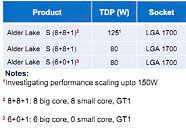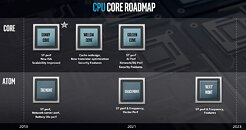Monday, March 9th 2020

Rumor: Intel to Introduce Big.Little Architecture for Desktop With Alder Lake-S, New LGA 1700 Socket
Hold on to your helmets: a wild rumor that Intel may be looking to introduce the same design considerations as they already did with their Lakefield architecture has appeared. According to momomo via Twitter (a user who has already shared many rumors and details in the PC hardware space) as well as some other sources, Intel is looking to bring a Big.Little-like design (which Intel calls Hybrid architecture) to the desktop platform in the form of Alder Lake-S, to be reportedly built on the 10 nm process. While Intel's Lakefield (especially geared for the mobile market) only sported four Atom (Intel's low power) Tremont cores combined with one high-performance Sunny Cove core, Alder Lake-S could sport as many as an 8+8 configuration, with a TDP currently set up to 80 W (and up to 125 W TDP is also set in the revealing slides with a disclosure regarding investigating performance scaling in up to 150 W TDP).
Should this actual Alder Lake-S product materialize in the 10 nm process, this could be a way for Intel to salvage what it can from the 10 nm process for the desktop platform. As we know from multiple reports on the state of Intel's 10 nm, yields and operating frequencies aren't close to what was expected, and Intel's CFO George Davis even said at last week's Morgan Stanley's Analyst Conference that their 10 nm process wouldn't be as profitable as even 22 nm, which does show that Intel is already looking past this process for their 7 nm deployment. A Big.Little design for a desktop architecture does seem like a more plausible design decision for a struggling process than a full 16-core monolithic die such as those Intel currently employs.The leaked slide also points to a new socket, LGA 1700, which would supersede the LGA 1200 that's being deployed with Comet Lake-S (10th gen) and which could feature support for Intel's Rocket Lake-S family (11th Gen). The leak also plays out a possible PCIe 4.0 support from Alder Lake-S, which could mean this is the first Intel architecture to sport this updated protocol, should it not debut with Rocket Lake-S already. Slightly logic, rational leaps mean that Intel could be looking at leveraging their Golden Cove (high performance) and Gracemont (Atom) CPU cores for this hybrid design.
Sources:
via Tom's Hardware, momomo @ Twitter, Ghost Motley @ Twitter, via Videocardz, Anandtech
Should this actual Alder Lake-S product materialize in the 10 nm process, this could be a way for Intel to salvage what it can from the 10 nm process for the desktop platform. As we know from multiple reports on the state of Intel's 10 nm, yields and operating frequencies aren't close to what was expected, and Intel's CFO George Davis even said at last week's Morgan Stanley's Analyst Conference that their 10 nm process wouldn't be as profitable as even 22 nm, which does show that Intel is already looking past this process for their 7 nm deployment. A Big.Little design for a desktop architecture does seem like a more plausible design decision for a struggling process than a full 16-core monolithic die such as those Intel currently employs.The leaked slide also points to a new socket, LGA 1700, which would supersede the LGA 1200 that's being deployed with Comet Lake-S (10th gen) and which could feature support for Intel's Rocket Lake-S family (11th Gen). The leak also plays out a possible PCIe 4.0 support from Alder Lake-S, which could mean this is the first Intel architecture to sport this updated protocol, should it not debut with Rocket Lake-S already. Slightly logic, rational leaps mean that Intel could be looking at leveraging their Golden Cove (high performance) and Gracemont (Atom) CPU cores for this hybrid design.


68 Comments on Rumor: Intel to Introduce Big.Little Architecture for Desktop With Alder Lake-S, New LGA 1700 Socket
AMD's GPUs can idle at as low as 20-30 MHz. AMD has always been known for not working optimally with the frequencies, they just need time to adjust everything properly.
Example, HD 4890 didn't lower its memory clocks and they always run at 100%.
Some sources would be good though, instead of just hip shots.
Looks like its a bit of both, at the very least. Regardless, because we've drifted off topic a little... there is STILL a gain here because being able to shut the CPU off entirely is of course profit anyway, over leaving it at a low voltage. If we discard the board from the total system power equation, there is still a significant chunk of idle usage there from the CPU in both camps. I mean this is 50W idle we're talking about. The board takes 4-8W... on desktop.
Of course we also can't just directly translate these numbers to a laptop situation with ditto CPU, but if Zen is a single chiplet that cannot be shut off versus a BIG little setup where the biggest idle usage can be removed, it needs no explanation what will be preferable for battery life. No matter how low and well it can clock down. Most devices are in idle most of the time...
With Intel Rocket Lake CPU support
Intel LGA 1700 socket PCIe 5.0 (DMI 5.0) "DDR5 USB4 WiFi-6E
With Intel Meteor Lake CPU support
Meteor Lake is Intel 7nm